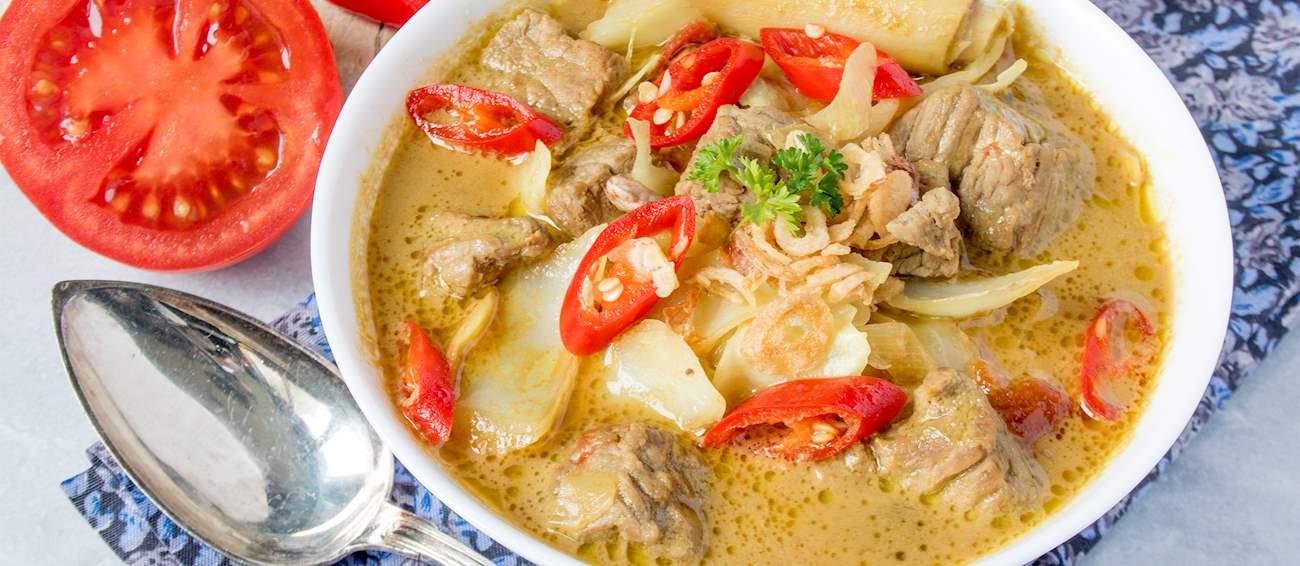Indonesian chicken stew is based on an aromatic combination of coconut milk and numerous spices such as lemongrass, tamarind, cinnamon, galangal, palm sugar, coriander, garlic, and shallots. The dish is typically prepared with bone-in pieces such as thighs or drumsticks, or sometimes even a whole chicken that is cut into pieces.
The dish is usually associated with Java and it belongs to a wider group of opor dishes that employ the coconut milk braising technique. Opor ayam is typically enjoyed at Eid al-Fitrat – a religious festival that celebrates the end of Ramadan.
Predominantly sweet, slightly robust, and deliciously spicy, tongseng is an authentic Indonesian meat stew, typically goat, cooked with kecap manis (sweet soy sauce), shredded cabbage, tomatoes, and coconut milk. It is commonly regarded as a combination of satay, meat skewers, and gulai, Indonesian curry.
This Javanese delicacy is replete with exotic herbs and spices that give it an exquisite flavor, while the coconut milk gives it a smooth, creamy texture. Beef, mutton, and even chicken are alternatives to the goat meat. Also, it is not uncommon to leave the bones and offal of the meat while cooking the dish for a richer flavor.
MAIN INGREDIENTS
This Indonesian goat stew originated in Surakarta, Java. It is believed that the dish appeared during the Dutch rule when the best goat cuts were usually distributed among the rich, and what was left for the poor were goat bones which still had some meat attached to them.
The bones are cooked in a thin, coconut-milk-based broth that is enriched with various herbs and spices such as turmeric, galangal, lemongrass, cumin, coriander, garlic, and onions, while some establishments also may include the addition of goat innards.
MOST ICONIC Tengkleng
View moreMAIN INGREDIENTS
Semur daging is a traditional stew originating from Java. It is usually made with a combination of beef, onions, garlic, ginger, kecap manis, palm sugar, tamarind, cloves, nutmeg, cinnamon, cardamom, oil, salt, and pepper. The onions, garlic, and ginger are seasoned with salt and fried in oil.
The meat is cut into cubes and added to the pan with spices, kecap manis, sugar, and water. The stew is simmered over low heat until the meat becomes tender and the sauce is reduced. It is recommended to serve semur daging with rice and vegetables on the side.
Gudeg Yogya is a traditional dish originating from Yogyakarta. This stew is usually made with a combination of young jackfruit, coconut milk, hard-boiled eggs, kaffir lime leaves, lemongrass, galangal, palm sugar, salt, and a spice paste consisting of shallots, candlenuts, garlic, and coriander seeds.
The ingredients are simmered over medium heat until the sauce is reduced by half, and the hard-boiled eggs are then added to the stew and cooked until the sauce is absorbed by the jackfruit and eggs. Gudeg Yogya is served warm or at room temperature.
MAIN INGREDIENTS
Semur ayam is a traditional dish originating from Java. The dish is usually made with a combination of chicken, potatoes, sweet soy sauce (kecap manis), nutmeg, lemongrass, garlic, shallots, ginger, sugar, salt, and pepper. The shallots, garlic, ginger, and lemongrass are sautéed in oil, and the chicken pieces are then added to the pan, followed by the rest of the ingredients.
The mixture is brought to a boil and simmered until both the potatoes and the chicken become tender. Semur ayam is served hot with steamed rice on the side. If desired, the stew can be garnished with fried shallots.
TasteAtlas food rankings are based on the ratings of the TasteAtlas audience, with a series of mechanisms that recognize real users and that ignore bot, nationalist or local patriotic ratings, and give additional value to the ratings of users that the system recognizes as knowledgeable. TasteAtlas Rankings should not be seen as the final global conclusion about food. Their purpose is to promote excellent local foods, instill pride in traditional dishes, and arouse curiosity about dishes you haven’t tried.












